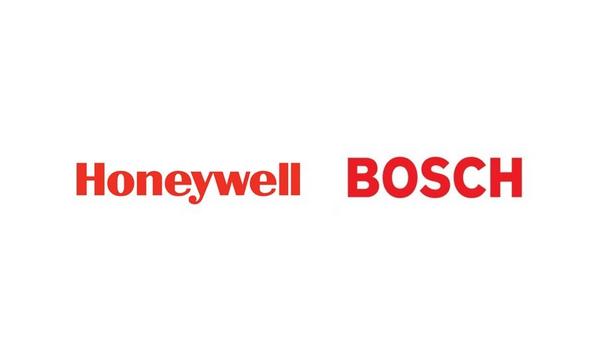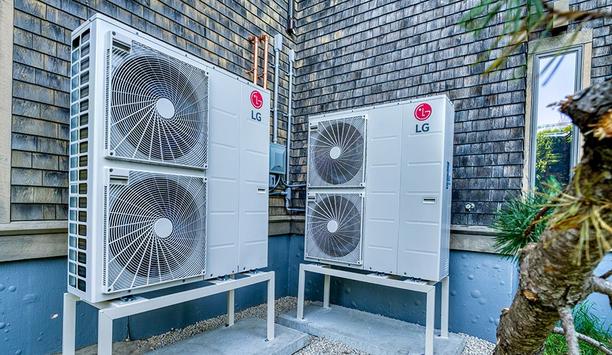Honeywell Advanced Materials - Experts & Thought Leaders
White papers from Honeywell Advanced Materials
Benefits Of Solstice® ze In Commercial And Industrial Applications
DownloadLatest Honeywell Advanced Materials news & announcements
Honeywell announced that Bosch’s newest line of heat pumps will incorporate Honeywell’s energy-efficient Solstice low-global warming potential (GWP) refrigerant. As part of this collaboration, Bosch technicians will be trained in the safe maintenance and installation of these next-generation low-GWP solutions. The collaboration with Bosch also supports Honeywell’s recently announced plans to align its portfolio around three compelling megatrends, including the energy transition. integration reduces GHGs Bosch’s Florida Heat Pump series will use Honeywell Solstice® 454B refrigerant, designed to reduce greenhouse gas emissions in residential and light commercial heating and air conditioning by 78% compared to traditional refrigerants. With the integration of Honeywell Solstice, Bosch’s heat pumps will be able to use a combination of both electricity and refrigerants to move heat, providing an energy-efficient alternative to heating and cooling via traditional furnaces and air conditioners. low-GWP refrigerant “Honeywell continues to pioneer next-generation refrigerants for the industry that enable our global partners to meet their carbon footprint targets,” said Jeff Dormo, president of Honeywell Advanced Materials. “Bosch's selection of Honeywell's low-GWP refrigerant reflects our joint commitment to environmental responsibility and underscores our strategic alignment in assisting companies with their energy transition, mitigating the environmental impact of heating and cooling systems.” best practices Honeywell and Bosch are also partnering together to share important technical information on the refrigerant change The heating and cooling industry is undergoing a significant change in refrigerants, driven primarily by regulations under the EPA American Innovation and Manufacturing (AIM) Act in the United States. To help installers prepare for the transition, Honeywell and Bosch are also partnering together to share important technical information on the refrigerant change and to ensure technicians know the best practices for the safe handling, maintenance, and installation of these new refrigerants. emphasis on Contractor Education “Bosch Home Comfort deeply values professional training on both the technology and best practices for safely installing the equipment as designed,” said Dr. Alexander Wuthnow, president and CEO of Bosch Home Comfort North America. We are proud to partner with Honeywell to make critical resources easily accessible to installers" “As the industry pivots to lower global warming potential refrigerants, contractor education will become even more critical in 2024 and beyond. We are proud to partner with Honeywell to make critical resources easily accessible to installers and to further drive excellence and innovation in the industry.” Solstice technology Honeywell has invested more than $1 billion in research, development, and the creation of new capacity for its Solstice technology, which currently has applications in refrigerants, blowing agents, aerosols, and solvents and is also being evaluated for expanded use in metered dose inhalers. Since its introduction in 2011, the use of Honeywell Solstice technology has helped avoid the potential release of the equivalent of more than 326 million metric tons of carbon dioxide into the atmosphere or the carbon emissions from nearly 70 million gasoline-powered passenger vehicles per year.
Honeywell announced that Hisense, a global consumer electronics and appliance manufacturer, will incorporate Honeywell's energy-efficient Solstice low-global warming potential (GWP) refrigerant into its residential air conditioning units. Hisense units will use Honeywell Solstice® 454B, a low-GWP refrigerant acknowledged for its outstanding performance in both cooling and heating. Hisense’s decision to integrate Honeywell’s Solstice refrigerant is in line with global efforts to phase out higher GWP refrigerants for air conditioners and heat pumps. Technological advancements "Driven by a commitment to pioneering scientific and technological advancements, Hisense relentlessly strives to enhance the quality of life and bring boundless joy to countless families,” said Hao Wang, general manager of the Supply Chain Management Department at Hisense. “Our alliance with Honeywell signifies a formidable leap towards sustainability, as we integrate cutting-edge refrigerants into our industry-pioneering air conditioning units, ensuring unparalleled cooling efficacy with minimal environmental impact." Use of high-HFCs Integration of Honeywell’s Solstice refrigerant into Hisense units comes amidst the recent increase The integration of Honeywell’s Solstice refrigerant into Hisense units comes amidst the recent increase in legislative mandates across the country to reduce the use of high-GWP hydrofluorocarbons (HFCs) in response to the growing global emphasis on addressing climate change. The partnership between Hisense and Honeywell also follows the U.S. Environmental Protection Agency’s recent announcement of a 40% quota cut in the production of HFC refrigerants as of January 1, 2024. Lower carbon footprints “The world is migrating away from refrigerants with high-global warming potential, but it is also accelerating innovation to create responsible replacements that lower carbon footprints and improve energy efficiency, all without sacrificing safety and end-product performance,” said Jeff Dormo, president of Honeywell Advanced Materials. “Honeywell anticipated the need for these solutions more than a decade ago when we introduced our Solstice technology, and today we are pleased to be able to partner with manufacturers like Hisense that are leveraging our expertise to enhance their own sustainability efforts in alignment with the global energy transition.” New capacity for its Solstice technology Honeywell has invested more than $1 billion in research, development and the creation of new capacity for its Solstice technology, which currently has applications in refrigerants, blowing agents, aerosols and solvents, and is also being evaluated for expanded use in metered dose inhalers. Since its introduction in 2011, the use of Honeywell Solstice technology has helped avoid the potential release of the equivalent of more than 326 million metric tons of carbon dioxide into the atmosphere or the carbon emissions from nearly 70 million gasoline-powered passenger vehicles per year.
Eurovent Middle East announces that Honeywell has become the latest addition to a growing group of industry players that are coming together to support the transition to more sustainable technologies in the Middle East. This signifies the growing importance of collaboration among industry organizations to promote progress. Building management Mr. Tariq Al Ghussein, President of Eurovent Middle East, welcomes Honeywell, “With Honeywell, another big name in the industry is joining our efforts to provide an organized and coordinated approach to the region’s challenges in our sector." "Building management is one of the key elements in energy efficient building operations and the discussions during our congress last year showed that the region needs to speed up the transition towards lower global warming potential (GWP) refrigerants. For both areas, Honeywell will be an excellent addition to our joint competence as an organization.” Honeywell The company delivers industry-specific solutions that include aerospace products and services Honeywell has more than 100 years of experience innovating. The company delivers industry-specific solutions that include aerospace products and services; control technologies for buildings and industry; and performance materials globally. Honeywell’s technologies help aircraft, buildings, manufacturing plants, supply chains, and workers become more connected to make the world smarter, safer, and more sustainable. Solstice portfolio “As the Middle East places an increased focus on sustainability, Honeywell’s Solstice portfolio of low-GWP and more energy-efficient HFO refrigerants, as well as building technologies that help create safe, efficient, and productive facilities, are ready-now to help,” said George Bou Mitri, Vice President and General Manager, Middle East, and North Africa, Honeywell Performance Materials & Technologies. “Joining an industry association like Eurovent Middle East allows Honeywell and other organizations to support the region’s environmental transformation.”
Insights & Opinions from thought leaders at Honeywell Advanced Materials
The HVAC market is a rapidly changing environment on a variety of fronts, from the introduction of new refrigerants to the increasing use of artificial intelligence to the embrace of interconnected systems in the Internet of Things (IoT) environment. We asked our Expert Panel Roundtable: How will the HVAC market change in the next five years?
Like most industries, the future of the HVAC market is being driven by technology. In the world of HVAC as in life, technology touches nearly everything we do. Changes in technology can affect the demand for various products or even make products obsolete. Current technology shifts in HVAC are likely to have profound impacts and change the industry as we know it. We asked our Expert Panel Roundtable: What is the biggest technology change currently happening in the HVAC market?
A landmark UN scientific study has once again highlighted the short window available to prevent irreversible climate change. Businesses are coming under pressure to dramatically accelerate their net-zero carbon initiatives. This comes at a time where market dynamism is returning across a range of key sectors following a downturn triggered by the pandemic. Businesses are also being pressured by stakeholders to recover revenues lost during the pandemic and to start rebuilding commercial activity. Typical supermarket products With refrigeration sitting at the heart of some of the biggest industries across the globe, including food commerce, healthcare, manufacturing and technology, decisions on refrigerant technology tap into the heart of the debate around environmental credibility, consumer expectations and economic recovery. So how can businesses balance the need to adopt more environmentally-preferable refrigerants with the urgent need to boost revenues? The technology factors into many of the most important facets of modern society Often when you think of refrigeration, you instantly think of cold storage and supermarket refrigeration. Without refrigerants, we wouldn’t be able to extend the life of many typical supermarket products or have the convenience of home storage. However, that isn’t the only role refrigeration play in our daily lives. In fact, the technology factors into many of the most important facets of modern society. The healthcare sectors, for example, would struggle to reduce the spread of infection without the use of modern air-conditioning, while the pharmaceutical industry requires refrigeration to store life-saving medications. Preserving human life On top of this, the digital revolution would not be possible. Without coolants, the data centers run by companies such as Amazon, Facebook and Google would overheat, resulting in system failures and service outages. And finally, with temperatures rising across the planet because of global warming, and heatwave events becoming more common, refrigeration is increasingly important to preserving human life. Without refrigerants, recent extreme weather events would have been even more devastating. However, although refrigeration has been a solution for many human challenges, finding a refrigerant that is both safe and environmentally preferable is a challenge. In fact, before recent breakthroughs, many of the chemicals used as refrigerants, such as ammonia, sulphur dioxide, carbon dioxide and methyl chloride, were poisonous, corrosive and even explosive. Non-Flammable alternative CFCs were found to be extremely harmful to the ozone layer and were therefore phased out In the 1930s, a compound called chlorofluorocarbons (CFCs) was commercially introduced as a non-toxic, non-flammable alternative to established refrigerants and was in widespread use for a variety of applications by the mid-20th Century. However, CFCs were found to be extremely harmful to the ozone layer and were therefore phased out in favor of hydrofluorocarbons (HFCs). The story wouldn’t end there, however, as HFCs were found to be potent greenhouse gases with high global warming potential (GWP). EU regulators therefore demanded their phase-out from 2016. By 2024, HFCs must be phased out so industries have been scrambling to find alternative low-global-warming-potential solutions. Unique chemical bonds The answer came in the form of hydrofluoroolefins (HFOs), developed by renowned chemist, Rajiv Singh. HFOs are known for their unique chemical bonds, which allow them to break down in just a few days, so they don’t linger in the atmosphere if released and therefore don’t meaningfully contribute to global warming. Since launching its Solstice line of HFO refrigerants in 2012, Honeywell has averted the production of more than 200 million metric tons of greenhouse gases, equivalent to emissions from more than 42 million cars, more than all passenger cars in Germany. Honeywell has averted the production of more than 200 million metric tons of greenhouse gases The automotive industry was one of the first sectors to recognize the strengths of HFOs. During the past 10 years, nearly 75 million cars made in Europe have been fitted with HFO-based air conditioning systems. Supermarkets have also been reaping the benefits; more than 30,000 grocery stores currently use Honeywell’s non-flammable HFO refrigerant, Solstice N40, reducing their energy consumption by 10% and their global warming potential by a factor of three. Residential heat-Pumps HFOs are on the brink of being adopted for domestic use as well. New Honeywell HFO solutions are ideal for residential heat-pumps which enable the elimination of fossil fuel burning in our homes, for heating and for hot water generation. HFOs superior performance deliver ‘best-in-class’ energy efficiency, hence enabling heat pumps to generate more renewable energy from the waste heat vs. alternative solutions. As enablers for energy efficient solutions and systems, HFOs also offer unique opportunities for future developments such as domestic air conditioning, cooling of electronic vehicle batteries and the fast growth of data center cooling. The ‘Green Deal’ is EU flag ship regulation on climate and economy recovery. Overall, buildings are responsible for about 40% of the EU’s total energy consumption, and for 36% of its greenhouse gas emissions from energy. Greenhouse gas emissions These new regulations and the corporation sustainability goals create a range of new opportunities To make it specific, heating and cooling, in the EU is responsible for 80% of energy consumed in residential buildings. Rapid adoption of Heat pumps and improved energy efficient solutions; are key contributors for Europe to reach the ‘Green Deal’ goal of being carbon neutral by 2050 and the recently adopted accelerated ‘fit for 55’ goal to reduce net greenhouse gas emissions by at least 55% by 2030. Adopting Low Global warning refrigerant, safe & energy efficient cooling solutions and replacing fossil fuel burners with heat pump systems to generate heat; are also key contributors to corporations’ sustainability goals (ESG). These new regulations and the corporation sustainability goals create a range of new opportunities for HFO solutions. As the popularity of HFOs grows, they’ll have a major role in mitigating climate change and enabling a carbon neutral economy. Pharmaceutical supply chains Happily, what’s good for the environment is also good for the economy. HFO production is already creating thousands of long-lasting jobs. The global pandemic stopped many people from enjoying a range of everyday pleasures such as visits to sporting events, restaurants and cinemas; activities at venues that are often reliant on some form of air conditioning and refrigeration, a sharp reminder of the role played by modern refrigerants. The technology continues to develop and evolve ensuring that a range of activities can continue to happen. From protecting the food and pharmaceutical supply chains to ensuring the continued operation of modern communication technology, next generation refrigerants will support some of the most important parts of the modern economy and a better environment.
Leveraging Radiant And Hydronics To Help Achieve Decarbonization Goals
DownloadSealed Connectors In Harsh Environments
DownloadPowering And Cooling Next Generation Data Centers
DownloadDebunking Myths To Promote A Bright Future For Heat Pumps
DownloadOptimizing Comfort: The Ultimate HVAC Component Guide
Download
















